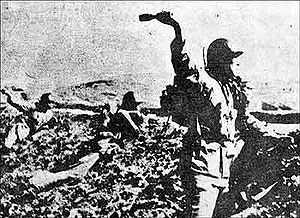- Defense of Hengyang
-
Defense of Hengyang Part of the Second Sino-Japanese War 
Date June 22, 1944-August 8th, 1944 Location Hengyang, Hunan province Result Japanese captured Hengyang Belligerents  National Revolutionary Army
National Revolutionary Army Imperial Japanese Army
Imperial Japanese ArmyCommanders and leaders  Fang Xianjue
Fang Xianjue Isamu Yokoyama
Isamu YokoyamaStrength 10th corps, 17,000 men 11th army, 100,000 men Casualties and losses Unknown Unknown The Battle of Hengyang was the longest defense of a single city of the entire Second Sino-Japanese War. When Changsha fell to the Imperial Japanese Army on June 19, 1944, Hengyang became their next target. The reorganized 11th Army, consisting of 10 divisions, 4 brigades, and over 100,000 men, assumed the task of attacking Hengyang.
The city was an important railroad junction and Hengyang Airport was used by USAAC General Claire Lee Chennault's Flying Tigers which were engaged in bombing operations of the Japanese homeland. Therefore, Field Marshal Hajime Sugiyama(杉山 元), chief of imperial staff and war minister, ordered the city must be taken at all costs.
On June 22, Japanese 68th and 116th divisions received their orders to attack the city, which started the 48 days of siege and defense.
The battle
After Changsha was lost to the Japanese, the Chinese army had a difficult time to reestablish their line of defense due to overwhelming Japanese advantages in manpower and materiel. The two-star Lieutenant General Fang Xianjue(zh:方先覺) had one single understrength Tenth Corps, although it had four divisions of 3rd, Reserved 10th, 190th, and Temporary 54th, the entire unit was made up of seven understaffed regiments of 17,000 men.
The Chinese commander ordered a mandatory evacuation for 300,000 inhabitants of the city, abandoned some defensive positions south of the city, and began to construct earthworks, trenches, pillboxes, bunkers and machine-gun nests. The city was protected by two rivers and marshlands and the Japanese could only advance from the south. The Chinese created man-made cliffs of 6 meters high, and covered the place with well-placed mortar and light artillery.
If the Japanese army wanted to take the city, they would sustain large casualties. On June 22, 1944, the Imperial Japanese Army Air Service began dropping incendiary bombs on the city, and two Japanese 68th and 116th divisions of the 11th army attacked the city at eight o'clock that night. The Japanese assault lasted until July 2. They were forced to call a halt due to increasing casualties and decreasing supplies of ammunition.
In the morning of July 11, the Japanese launched their second try, and did not score any major success despite some small gains. On August 4, lieutenant general Isamu Yokoyama(橫山 勇) ordered three divisions to reinforce the 68th and 116th divisions. After four days of intense bombing and artillery shelling, the Chinese garrison was reduced to 2,000 wounded men, less than a regiment (3,000).
The Japanese troops killed around 1,000 wounded Chinese in the Hengyang hospital before engaging in negotiations. General Fang tried to commit suicide, but his officers stopped him and tried to negotiate a truce with the Japanese. After the Japanese agreed not to harm the civilian population and to treat Chinese wounded humanely, General Fang ordered the remaining Chinese soldiers to lay down their arms on August 8, 1944.
The aftermath
Although the Japanese army suffered huge losses, they held the Chinese commanders in high regard. Japanese Emperor Hirohito personally appointed General Fang Xianjue as commander of a puppet unit, made up of his remaining garrison and some Chinese turncoats. But the local Japanese commanders never trusted him or his officers; they were eventually placed under house arrest.
Chinese special forces under General Dai Li(zh:戴笠), head of China's wartime intelligence service "Military-Statistics Bureau" of National Military Council, carried out a daring rescue mission and freed General Fang and his officers in December 1944. They returned to Chungking to a hero's welcome and were decorated with the order of blue sky and white cloud, the highest honor for a Chinese commander.
The delay at Hengyang cost the Imperial Japanese Army considerable time and the Tojo cabinet collapsed as the war was not in Japan's favor anymore. Lieutenant General Yokoyama was later relieved of his command due to his refusal to obey orders from General Yasuji Okamura(zh:岡村寧次), commander-in-chief of the Japanese China Expeditionary Forces.
The Japanese operation in Hunan did manage to push Chinese troops out of the area, but they could not secure the territory around the railroad or safely transfer war materials to different regions. Because of increased activity of Chinese troops and nationalist guerrillas, they could take no more Chinese land.
Categories:- Battles of the Second Sino-Japanese War
- 1944 in China
- 1944 in Japan
Wikimedia Foundation. 2010.
